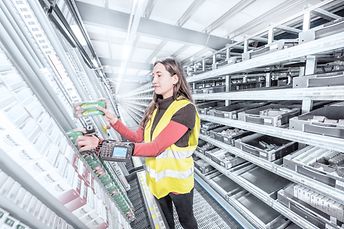THE INTERNET OF THINGS (IOT) AND WAREHOUSE DATA – WHAT DO THEY HAVE IN COMMON?
Technology is always evolving, which drives change both in what consumers purchase and how they receive their purchases. Technology also drives change in the logistics industry, especially over the past few decades.
Technological advancements often lead to buzz words that get used in the industry. One of the hot topic now—the concept of an Internet of Things (IoT) with warehouse data and your warehouse management system (WMS).
Well, what is the IoT? It’s usually defined as the interconnection via the Internet of computing devices embedded in everyday objects that can send and receive data. This data is the core of the matter for logistics — but how can it be used to help consumers and warehouses alike?
Connecting with Customers
With digitalization, customers like the ease of ordering online and receiving deliveries at their doorstep or for in-store pickup. And this, both e-commerce and omnichannel retailers know that. It’s easy to see the appeal, since convenience is an important criteria for the end customer. Just think about order status and shipping alerts that get delivered to the customer. Thanks to these, customers know exactly where their product is, if it’s on time, and where it is in transit at any moment—given that it gets scanned throughout the supply chain and fulfillment journey.
Utilizing the theory of IoT and with the latest advances in warehouse and fulfillment systems, tremendous amounts of data are generated. With a smart WMS, like WAMAS®, this information can be queried and communicated to host systems that provide real-time feedback and information so the - end user knows exactly where their order is at any point during the fulfillment process.
This drives decision making that can lead to bigger baskets — like adding additional items. Or, a customer can change the attributes of an item, like size, color, and fit. Perhaps after placing their order, the customer wants to upgrade shipping, too. Giving feedback to the customer through automated channels provides additional revenue growth by simply offering order fulfillment feedback.
By using the Internet of Things for warehousing data, companies can push their customer reach even further. While some mobile apps now update you with notifications, personal home assistants interact through vocal communications with customers. These are on the rise and can be a great tool for product updates — customers can come home to a greeting telling them their order is on the way, or if a product is in inventory.
Connecting within Distribution Centers
Data is vital in enhancing the end user consumer experience, but it is just as crucial to the warehousing experience. As items in the supply chain make their way to their destination, they interact with a series of scanners and sensors. Wearable technology is already an option that allows employees within a DC to scan items from a device on their wrist.

But with IoT, data is collected from sensors that are stored within the automated machinery itself. Sensors paired with scanning machines can interconnect with a centralized hub, network, smart phone, virtual assistant, and back to a central WMS.
Distribution centers can take advantage of the interconnected nature of IoT to monitor their own data, with everything from best storage options to best labour management practices. After all, every bit of optimization results in a better customer experience in the end. Real state-of-the-art systems are able to disseminate and present data in real time to operators so decisions can be made accurately instead of gut feelings or historical knowledge.
Connect with Easy Insights
Being able to communicate with third-party software, along with inventory and fulfillment data, allows any retailer to stay a step ahead. With WAMAS®, the WMS from SSI SCHAEFER, warehouse operators get a configurable dashboard setting, allowing easy user interface to obtain insights with just a glance while also boasting data export features that ensure data can easily be shared across multiple teams—and even consumers.